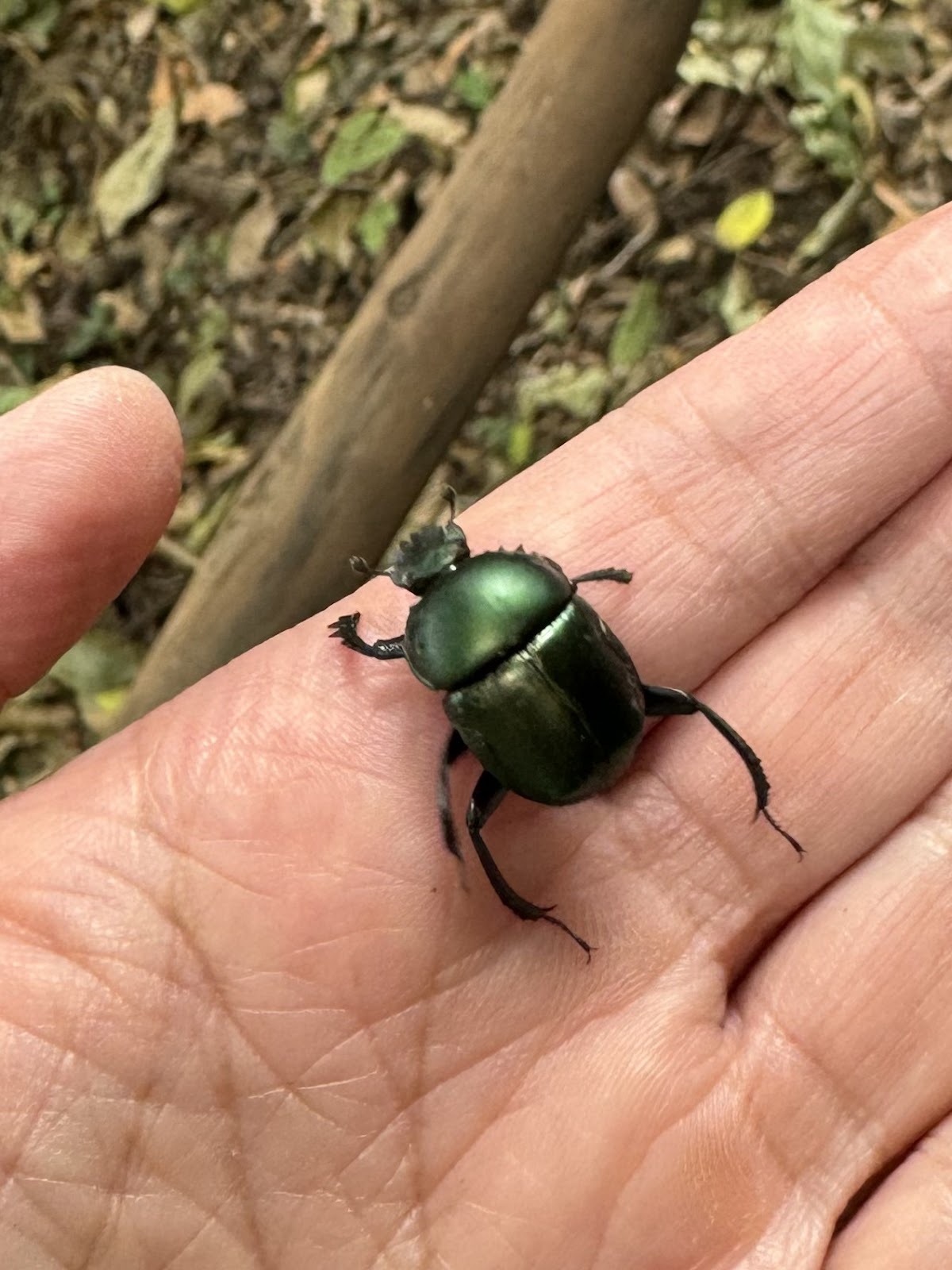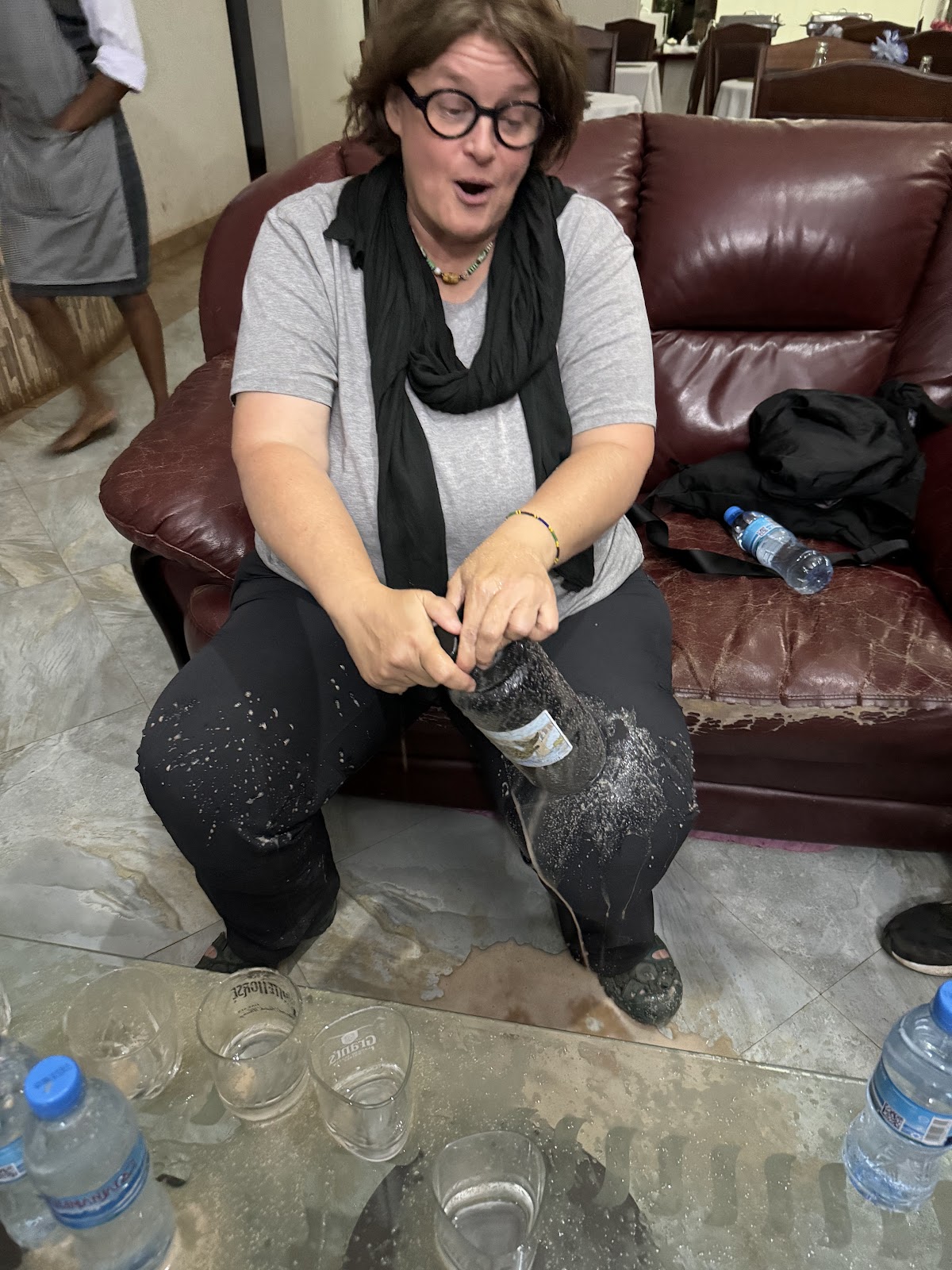 |
| Allie, Rubin, and me - exploring the streets of Moshi |
It was about a 2.5 hour drive to Moshi, stopping in Arusha for a quick lunch. By the time we got to our new hotel – the Sangana Lodge – we were all exhausted and sore. Allie, Rubin, and I went for a quick walk around the block (but were warned that it wasn’t the best neighborhood and to avoid nearby areas because there had been petty crime in the past.) Even so, it was nice to stretch our legs since I’m a bit worried that zero exercise these past few weeks is going to turn the Kilimanjaro hike into quite a challenge!
FRIDAY, July 19
Early in the morning, Jannice, Allie, Rashid, and I went birdwatching in the neighborhood near Sangana Lodge. This region has amazing biodiversity, and it was nice to see so many different species than we had encountered in Zanzibar. It was also a peaceful way to start the day, which I definitely appreciate since each day is filled with overstimulation!
 |
| The main roundabout in Moshi: Water for Life |
Our morning was spent at the College of African Wildlife Management (or Mweka Wildlife College), hearing about climate change impacts to Mt. Kilimanjaro and particularly about the sources of water on and around the mountain. We learned that much of the water is not from glacier melt, but from the montane forests that surround the base of the mountain. The area is dense with vegetation, with moss-covered trees and a thick understory with shrubs and ferns. There is high humidity and significant rainfall, but the upper bound of the forest is shrinking – due in large part to human-caused forest fires that are happening more frequently and with greater intensity. With less forest, there are fewer trees resulting in less rainfall, perpetuating the cycle.
 |
Wandering vendors - they display
their goods on their heads! |
After lunch at the college, we returned to Sangana for a free afternoon. Rubin, Allie, and I walked into downtown Moshi to see the city and to find a place to work.
 |
| Roadside stalls in Moshi |
Unlike friendly and walkable Stone Town, Moshi’s busy streets often have no sidewalks, and interactions with the people seem more like heckling or harassment than the welcoming amiability of the Zanzibaris. We walked quickly through town and made it to Coffee Union Café, where we met up with Ann and Anne-Marie, but there was no wifi so after a quick drink, we wandered to Blossom’s Café where we found a lovely outdoor seating area. We had an early dinner while we worked, which made for a nice and productive way to spend the day.
SATURDAY, July 20
Jannice, T’Shango, Rashid, and I went birdwatching this morning, and we luckily caught a glimpse of a mongoose running across the road! Too bad he was too quick for a photo...
 |
| Thank you, Mweka Wildlife College! |
This morning was spent back at Mweka Wildlife College, where we had a discussion about how local communities were dealing with the changes in the environment around Kilimanjaro. There were different coping strategies that the people were using to face human-wildlife conflicts, water fluctuations, and weather instability. An interesting concept that is used by local people is the idea of 'ujamaa' - broadly, "cooperative economics". Rather than competing for limited resources, they cooperate with each other to provide for the essentials of living.

After lunch, we explored the Chagga Bolt Hole that was on Mweka College’s campus. It was interesting to note that there was this important archaeological site located on campus, but it was probably overlooked by most of the students. The Chagga are the primary ethnic group living around Kilimanjaro. They built an underground tunnel system into the volcanic soil as a defense during times of conflict. Some of the rooms were large enough to hold their livestock, so families could hide out for days or even weeks at a time.
 |
| Retreat! RETREAT!! |
The tunnels at Mweka were covered with heavy metal doors, but surprisingly they weren’t locked and we were able to wander inside. We were led by T’Shango and Rashid, who discovered there were bats (and cockroaches) and they scared us all back out. But there were others in our group who had missed the expedition, so we returned and went back down into the tunnels (but again, didn’t get far). The tunnel system reminded us a bit of the Cu Chi tunnels of Vietnam, only much wider and not nearly as stifling hot!
 |
| Tuk tuks were the way around town! |
That afternoon we spent time preparing for our trek to Kilimanjaro – we knew we’d have to carry all our own personal items, so we did our best to pare down to the bare minimum. The problem is that the First Huts, where we’d be spending the night, was at nearly 9,000 ft in elevation and could potentially be very cold. So we needed to pack a rainjacket and extra clothing, as well as enough water to get us up the 8-kilometer long uphill (about 2,600 ft gain in elevation!) trek. Plus, I was planning to bring my camera, which would add significant weight… quite the dilemma!
I'll write about the Kili hike in its own post!
WEDNESDAY, July 24
Today we visited the Cyril Chami Secondary School, near Mweka Wildlife College, where we spoke with three geography teachers as well as a group of students from their environmental science club. The session started with a Q&A with the teachers, who were all passionate about teaching climate change, but seemed to have very carefully crafted answers. The same seemed true about the student-focused session – about 10 students from the environmental science club came, and seemed very shy and nervous about answering our questions. There was definitely a language barrier, although we’d been old that all secondary schools were taught in English. It was understandable, given we were a group of around a dozen teachers from the United States, so they seemed afraid they would give a wrong answer.
 |
| With our hosts, the village elders |
That afternoon, we visited the village of Mongoya in the Longuo community at the base of Kilimanjaro. This community had set up an irrigation scheme where water was directed to the people via a system of canals and dikes; if a family chose to opt into the channel, they would be guaranteed water once a week, and could take water from the artificial streams. But there is definitely a cost barrier, as families need to buy into the program, as well as paying for the infrastructure to get the water onto their land.
THURSDAY, July 25 – Moshi
Today was spent working on our third artifact - we are each creating a project around the themes of water, ice, or education. From Rashid’s suggestion, I decided to use the photos I took to create trivia cards, with both facts and questions about each animal. Allie and Rubin joined, and they added landforms and locations to the deck as well.
Rashid took some of us to Lake Duluti this morning so that we could gather more information for our projects. Lake Duluti is a volcanic crater lake just 14 km east of Arusha, formed inside the caldera of an extinct volcano. It’s a nice and peaceful getaway from the nearby city, with hiking and boating opportunities plus lots of biodiversity. When we first arrived, we saw a hamerkop and night heron from the bus, so I knew there would be lots to see! We had a choice of canoeing or hiking, and since the lake level was extremely high (because of heavy rains the week before), we chose to hike partway round the lake.
That evening, we gathered to try out the banana wine that Anne-Marie and Ann had purchased that day from a random store in the village they had visited. They had stored it in a sealed water bottle, which promptly exploded when they tried to open it, spewing fermented banana all over the lobby.... disgusting!! I've never been so happy to not be a drinker... still, a nice bonding evening!
 |
| Cheers to new friendships! |
FRIDAY, July 26 – Moshi
On our final day in Moshi, we had free time to work on our artifacts. A small group chose to head downtown to our old haunt Blossom’s café, since there was reliable internet and good food. After working on our artifacts for the morning, we wandered around town to look for souvenirs and Kilimanjaro coffee, which is grown throughout the region.
 |
| The poop-mixing pits |
Because we had learned about the benefits of biofuels, we decided to visit a local farmer who had installed the equipment needed to produce biofuel onto her property. Mama Mcho invited us onto her farm to see how she collects cow manure and allows it to 'ferment,' producing the methane needed for cooking. The leftover byproducts she uses to fertilize her crops (and the wastewater she says is a mosquito and fly deterrent that she sprays onto her cows).
 |
| How many people can you squeeze into one minivan...? |

















No comments:
Post a Comment